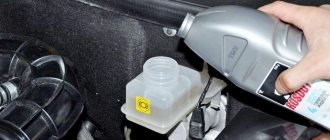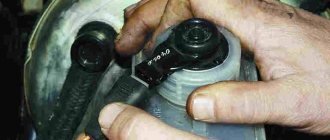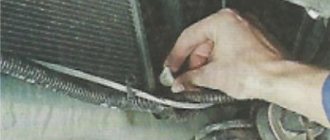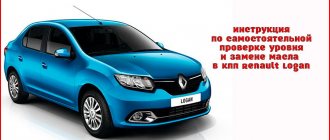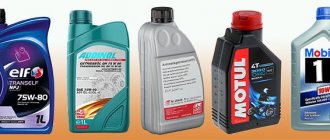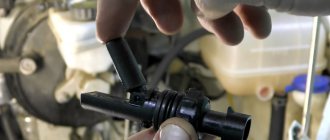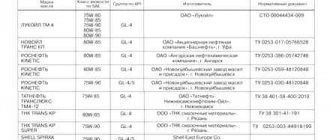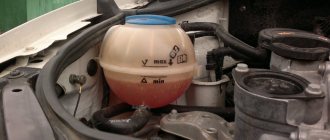The manufacturer recommends changing the brake fluid in the hydraulic brakes of the Lada Granta after 3 years of operation or 45 thousand km. mileage (whichever comes first). As a rule, this procedure is performed at a service station, but if you wish, you can service the VAZ 2190 brakes yourself.
You will need : an 8′ wrench for pipeline nuts, brake fluid, a rubber or transparent hose, a transparent container, a syringe or a rubber bulb.
For reference: Brake fluids used in the hydraulic brake drive system:
| ROSDOT | LLC 'Tosol-Sintez', Dzerzhinsk | TU 2451-004-36732629 |
| KAPROS-DOT | LLC 'Sibur-Neftekhim', Dzerzhinsk | TU 2451-030-52470175 |
Replacing brake fluid Lada Granta
Procedure:
Unscrew the master cylinder plug. Pump out the old brake fluid from the reservoir with a syringe or rubber bulb and fill with new DOT-4 brake fluid to the bottom edge of the reservoir filler neck. If the rear wheels are suspended, then first unlock the brake force regulator of the rear brake mechanisms. To do this, you need to insert a screwdriver between the plate and the piston (remove it when finished). Clean the air release valve of the right rear brake mechanism from dirt. Remove the rubber protective cap from the valve. Place a rubber hose (preferably transparent) onto the valve fitting and lower its end into a clean transparent container.
The assistant must sharply press the brake pedal 4 or 5 times (with an interval of 1-2 seconds), and then keep the pedal pressed. After which: Unscrew the air release valve 0.5-0.75 turns, and old (dirty) brake fluid will begin to flow out of the hose. The brake pedal should smoothly reach the stop. Close the valve after the liquid stops flowing. Constantly monitor the fluid level in the reservoir, do not allow it to fall below the 'MIN' mark. If necessary, add new brake fluid. Repeat steps 1-2 until clean brake fluid flows out of the hose. In a similar way, replace the brake fluid in the left front brake mechanism, and then in the second circuit (first in the left rear, then in the right front).
Finally, press the brake pedal several times. Grant brakes will perform their function when the pedal travel and resistance are constant with each application. If these conditions are not met, then air has entered the brake system and it needs to be bled.
Types and types of ABS anti-lock systems
Based on the number of control circuits, there are three types of anti-lock braking systems:
- single-channel - when one wheel is blocked, all four are released;
- two-channel - triggering occurs based on data from the best (high-threshold) or worst (low-threshold) wheel;
- four-channel - each wheel is adjusted separately, which ensures maximum braking efficiency.
Important! Modern cars are equipped with four-channel systems.
Depending on the location of components and maintenance features, there are three types of ABS:
- with components (hydraulic module, valves, accumulator and pump) located in a single unit;
- with components spaced in the form of different units;
- with optional SBC and ESP systems.
Despite the complicated design, it is quite possible to replace ABS brake fluid yourself.
Myths and legends
Replacing brake fluid with ABS often causes an abundance of all kinds of controversy among car enthusiasts. The myths associated with this liquid also add fuel to the fire.
The first is that brake fluid has an eternal life cycle. In fact, over time, the liquid may lose its prescribed qualities, since it is constantly in contact with air, which enters it through the compensation holes.
Second myth
The problem is that many people believe that it is quite common to mix liquids from different manufacturers. In reality, you can't do that. The thing is that for each type of car a composition is produced with its own characteristics and nuances.
Despite the generality of the prescribed recommendations for the production of such liquids. Mixing can be carried out only for a short period of time, and then with the condition that in the future a complete replacement of the brake fluid will be carried out.
New Lada: Lada Priora 2008: rim and wheel sizes, bolt pattern, tire pressure, wheel offset, DIA, PCD, drilling, standard tires and tuning
The third myth is the most extensive. He says that liquid of the DOT-4 standard can be used for filling into any car. As for the situation in real life, no, this liquid is not universal. And here it’s worth starting only from those species that have been officially recognized by the manufacturers themselves, and not throwing away and endangering everyone and everything.
As you can see, all these things are quite refutable, and if you follow them, then the path to problems is not far.
How to change brake fluid
It is best to do this at specialized service stations. Most modern cars have an ABS system, and this leaves its mark on the procedure. Special equipment is required to pump the system with new fluid.
If you are told that you can change brake fluid without bleeding without special equipment, then do not listen to this advice. Yes, on some wheels the pressure from the reservoir can push through the system, but on all of them this will not happen. As a result, air or old fluid will remain in the system. At service stations, fluid is replaced under pressure, so subsequent pumping is not required.
The replacement procedure itself is as follows. New fluid is poured into the empty expansion tank of the cooling system, after which pumping occurs on each line, during which the new fluid displaces the old one.
The average brake fluid volume ranges from 0.75 to 1.3 liters.
Changing brake fluid without special equipment is clearly described in the video below:
Do-it-yourself replacement of brake pads on a Lada Granta
The brake pads of the Lada Granta are quite reliable, but they still wear out and need to be replaced. The brake system on this car is the most common. Disc brakes at the front, drum brakes at the rear - this is a classic design. It is suitable for vehicles where high braking forces are unnecessary. Replacing rear and front pads is labor-intensive, but in this article we will look at the nuances.
When is it time to change brake pads
The service interval for Grants is 15 thousand km, or one year. The maintenance regulations dated 06.2021 require checking the condition of the front linings at every service, and the rear ones at every second.
The front linings are more accessible for technical inspection. Their thickness is visually determined by removing the wheel. They are visible through the caliper slots.
The ease of rotation of the wheel when the brake pedal is released can be easily assessed by turning it by hand. Such a check will not be superfluous, for example, when changing tires during the season.
Defects involve partial disassembly, inspection of all components, measurement of the residual thickness of parts, checking the functionality, mobility of components, and the tightness of the system. The maximum permissible thickness of the linings on the front and rear axles is 1.5 mm.
It is not possible to look under the rear drum to judge the thickness of the lining by eye. The drum must be removed.
The main signs of wear on the Lada Granta pads are a metallic grinding sound, an increase in pedal travel, a drop in the fluid level in the reservoir, an increase in braking distance, the car pulling to the side, beating, and deterioration in the effectiveness of the handbrake.
The mileage of pads before replacement is very individual. They structurally have different rigidity, and therefore resource.
Choosing pads for Grant
Pads are consumables. Sooner or later they will have to be replaced, so it is advisable to have a set in stock. Then, most likely, defects will smoothly turn into replacement, and the work can be completed faster.
The original pads are produced by the Russian company TIIR.
The catalog number of the front brake elements Grants with an anti-squeak plate is 21920-3501080-10.
At the rear, components are installed for both a system with and without ABS. The version for ABS differs not only in the hole for the sensor, but also in the lining material, adapted to work with the anti-lock system.
Catalog numbers of rear brake pads for Grant:
- With ABS - 21920-3502090-55
- without ABS - 2108-3502090
Among foreign analogues, such eminent manufacturers as TRW, ATE, Brembo, Bosch and others enjoy the largest number of positive reviews. They all produce high quality products. Therefore, the choice of the best parts depends on the preferences and financial capabilities of the owner.
For a quiet ride, softer linings are suitable, which will ensure comfort and safety of discs and drums. At the same time, they themselves wear out faster. The wear of brake elements for sports driving is more intense. There are pads with and without a wear sensor.
How to properly and quickly bleed ABS brakes with your own hands
The procedure for bleeding the brakes is influenced by the design of the system, the location of components and the presence of additional electronic modules. The correct sequence is important. You need to start by relieving the pressure in the hydraulic accumulator. To do this, you need to turn off the ignition (it is not necessary to start the engine) and pump the pedal.
A simple secret to quickly pumping brakes. Video:
Read how to bleed ABS brakes and stock up on the following materials, parts, accessories and tools:
Differences between ABS brakes
The main difficulty lies in ignorance of the nuances of operation and the main differences from the same procedure on conventional brakes.
Different car models have their own types of ABS, the design of which differs from each other. This leads to the fact that each brand of car has its own nuances of the system bleeding procedure.
Bleeding brakes with ABS has three main differences from conventional ones:
- the pipeline system in the presence of ABS is under increased pressure;
- During the procedure, constant monitoring of the brake fluid level will be required;
- the pump runs for no more than 10 minutes.
If you do not control the brake fluid level in the system, it will reach a critical minimum and the drive pump will begin to pump air.
This will quickly damage the device.
If the pump runs longer than the set 10 minutes, turn off the ignition and allow the unit to cool for 10-15 minutes.
LADA SUPER DOT-4
Domestic car owners will be interested in this original product, made specifically for VAZ vehicles. At the same time, the product fully complies with international standards, which is confirmed by a number of laboratory tests carried out in the United States of America.
The use of special patented additives allows you to increase the service life of hoses and seals. In addition, anti-corrosion additives prevent rust from developing on metal parts.
In principle, the best option for warranty service. The only serious disadvantage is that the composition cannot be mixed with other brake fluids.
Step by Step Actions
The nuances of pumping depend directly on the ABS model. The location of individual components and the presence or absence of additional modules affect the order of the procedure.
The preparatory stage is the same regardless of the car brand. Turn off the ignition and press the brake pedal intensely several times.
Pumping using the example of Lada Granta
The car is placed on an overpass or driven into a pit. This is necessary so that you do not have to remove the disks for free access to the working surface. Next, turn on the ignition to open the solenoid valves. Start the procedure with the right rear wheel.
To bleed the brakes you need:
- Disconnect the wires from the tank cap;
- remove the cover;
- pour brake fluid into the reservoir (as much as will fit);
- remove the cap;
- use a spanner wrench to loosen the tension on the fitting;
- the prepared hose is connected to the tip of the fitting;
- place the second end of the hose in a container for waste liquid;
- press the brake pedal several times;
- fix the pedal in the lowest position and hold it;
- use a key to open the fitting;
- wait until the liquid has completely drained (at this moment the brake pedal will “fall” to the floor);
- close the fitting;
- pump the pedal again and repeat the procedure until the liquid flowing from the hose no longer contains air bubbles;
- tighten the fitting;
- remove the hose;
- reinstall all parts.
The process is repeated on each wheel in order of priority.
Bleeding the brakes of Lada Priora
The process of bleeding the ABS brake system for the Lada Priora is similar to the previous one. When bleeding the front wheels, the discs are removed, providing better access to the working surface.
After completing the process, you should not immediately drive out onto the road. First, they check the functionality of the system in a safe area, eliminating leaks and failures of the pedal.
Sequence of actions when replacing fluid yourself
Necessary tools, materials:
- key to “10”, “14”, cylinder to “17”;
- rags;
- additional lighting;
- Pillbox for filling;
- new brake pads as needed.
Algorithm of actions:
- We hang the car with an electric lift.
- Open the hood.
- Unscrew the cap of the brake fluid expansion tank.
- We remove the wheel.
- In the cabin, a partner pumps the brake pedal and fixes it in the lower position. Waiting for commands.
- Clean the surface of the back of the brake caliper, remove dirt, and wipe dry.
- Using a key set to “10”, unscrew the grease fitting and bleed out the air along with the liquid.
- We tighten it and give a command to our partner to repeat the pumping procedure.
- We repeat the step again.
- We replenish the missing amount of DOT in the expansion tank.
After completing bleeding of one wheel, we immediately proceed to the next one according to the scheme:
- Front left – rear right;
- Front right – rear left.
The algorithm outlined above does not allow the complete replacement of bunkers in the contours. The design of the car is such that it is impossible to “flush” the system without major dismantling.
Many service station mechanics use a channel in the hydraulic drive to replace brake fluid:
- From the front of the engine we find the hydraulic drive fitting.
- Remove the plastic cap from it.
- We put on a hose, one end of which is lowered into a container with liquid.
- We recess the bracket.
- Pull out the plastic tube.
- The system has been depressurized and the bunker leaks out of the hose under pressure.
- As soon as the level in the expansion tank drops below the minimum, we replenish the missing amount.
- We repeat the cleansing procedure until the color of the DOT becomes transparent.
The volume of bunker that is filled into Lada Vesta is 1.5 liters.
Possible mistakes
In order for the procedure to be effective and not lead to new problems, you should know common mistakes. The most common ones include:
- mixing two different brake fluids;
- reducing the fluid level in the system to critical;
- pressure too high.
If you mix two brake fluids with different parameters, the rubber seals are damaged. The system becomes clogged with clots and stops working.
When the fluid level in the reservoir is too low, air gets into the brake system and it fails. Also, do not use excessive force when pumping. The recommended pressure in the tank is 0.8 atmospheres. If excessive pressure is created, the tank will leak.
What characteristics to pay attention to
If you don’t know which brake fluid is better, then you should take a closer look at the following characteristics:
- boiling temperature. This is the most important parameter, which is equally relevant for both emergency braking and normal use of the brakes;
- pour point. This is especially true for those vehicles that are operated in the northern regions;
- hygroscopicity. The lower this indicator, the longer the composition will serve you;
- presence of anti-corrosion and lubricants in the composition. Their addition will increase the service life of the brake system itself.
In addition, it is important that the substance is chemically neutral towards rubber, otherwise it can damage tubes, hoses and connecting elements.
When is brake fluid replacement necessary?
Many motorists simply top up the brake fluid, without particularly paying attention to either the recommendations from the service book or the objective signs of deterioration in braking efficiency. Meanwhile, a complete replacement of the fluid cannot be avoided if its level has dropped below the minimum mark and the corresponding symbol lights up on the instrument panel.
Of course, you can simply add fluid, but after that it is worth checking the serviceability of the brakes, since a drop in the level indicates a malfunction in the master cylinder or the fuel fluid supply system to the wheels.
Antifreeze
This is the liquid that cools the engine. We recommend checking the antifreeze level along with checking other vehicle fluids once a month.
You should also check the antifreeze level if the engine overheats, and if the warning icon lights up on the dashboard.
To check the fluid level, you need to find the correct reservoir under the hood. The antifreeze level in it should be between the MIN and MAX marks.
If the level is below the minimum, you need to top it up. Only add liquid of the same color as is already in the tank.
IMPORTANT: Do not exceed the maximum fluid level. When the engine is running, the fluid heats up and needs room to expand.
IMPORTANT: Do not open the reservoir cap until the engine has cooled. Otherwise, you risk serious burns. While the liquid is hot, it is under pressure in the tank.
Volume of brake fluid in the car
When a brake system repair is planned or a planned replacement of brake fluid is planned, the car owner thinks about how much brake fluid needs to be purchased to replace and completely fill the brake system. In a classic passenger car that is not equipped with ABS, TJ usually contains from 550 ml to 1 liter.
Information about what kind of liquid needs to be filled in, in the vast majority of cases (on Priora, Grant and other models popular in our country) can be found either on the body of the expansion tank or on its cap.
LIQUI MOLY SL6 DOT-4
When discussing which DOT 4 brake fluid is better, you cannot miss products from the famous German brand Liqui Moly. The cost is in the average price range.
At the same time, the substance also acts as an excellent lubricant, which guarantees stable operation of all mechanisms of the unit. I am also pleased with the complete neutrality in relation to rubber elements.
True, the boiling point is not so high - 230 degrees Celsius under normal conditions, and 155 degrees in case of increased humidity.
Below is a video on the topic “How long (when) to change the brake fluid”:
In addition, it is not recommended to use the substance in the northern regions of our country. But in mid-latitudes and for moderate driving there is no better option.
Domestic motorists highlight the advantages of Liqui Moly SL6 DOT-4, such as excellent anti-corrosion properties, as well as a gentle attitude towards rubber parts. Among the disadvantages, there is limited use in the northern regions.
Adding fluid or replacing it completely
If the car has covered 50-60 thousand kilometers or has been in use for 2-3 years, experts recommend completely updating the brake fluid, since the old one has already absorbed a lot of water and has partially lost its properties. Topping up the fluid may be necessary if the car has been idle for a long time or, conversely, is used too intensively and travels, for example, 80-100 thousand kilometers per year.
Much depends on the type of fluid, as well as driving style. Thus, an aggressive, sporty style may require more frequent brake replacement. As for its specifications, everything depends on the manufacturer’s recommendations. Thus, one of the most popular brands of Dot 4 is advised to be updated every 50-60 thousand mileage or after repair of the braking system.
-3-7-08-01erate)
Attention! If brake fluid gets on your car's paintwork, plastic parts, or wiring, it can cause damage. Remove it immediately with a clean cloth.
It is necessary to bleed the brake system hydraulic drive until new fluid (lighter than the old one) begins to come out of the bleeder fittings of all working cylinders.
We carry out pumping to replace the fluid with the engine not running, first on one circuit, and then on the other in the following sequence:
- right rear wheel brake;
- left front wheel brake mechanism;
- left rear wheel brake;
- brake mechanism of the right front wheel.
Before pumping, check the level of working fluid in the hydraulic brake reservoir. If necessary, add liquid.
To replace you will need:
- The brake fluid itself
- To remove old fluid syringe
- dry rag
- container for old liquid
- rubber hose, the diameter of which should be suitable for the bleed fittings on the wheels
- Special brake wrench 8 by 10 mm
First, we need to pump out the old brake fluid using a syringe, while leaving a small layer of it in the reservoir so that air does not get into the system.
Now fill the new brake fluid into the reservoir to the max level.
Now you need to completely remove the old fluid from the system by pumping it and filling it with new fluid.
Which brake fluid is better to choose?
We recommend choosing the fluid class recommended by AVTOVAZ, that is, DOT-4. To decide on a brand or manufacturer, you can rely on reviews from VAZ car owners. According to a survey, about 66% of motorists buy brake fluid in Dzerzhinsk. And not in vain, because in the tests of the ZaRulem magazine it is in good positions:
- SINTEC EURO DOT-6 (class 6)
- ROSDOT 6 DOT 4 (class 6)
- SINTEC SUPER DOT 4
- Lukoil DOT 4
- Hi-Gear DOT 4
- ROSDOT 4
- Sibiria Super DOT 4
- Rosa 4
- Felix DOT 4
- VITEX DOT 4
- RSQ PROFESSIONAL EURO DOT 4
- CHIMLUX DOT 4
- UNIX DOT 4
- PROMPEK DOT 4
DOT-4 Brake Fluid Test Results
. All brake fluids of the same class are compatible with each other. Are they different from each other? The answer to this question is given by the “Behind the Wheel” experts.
| Boiling point of “dry” liquid* | Reduced low temperature viscosity** | Present cost per unit of production | Final score | |||
| °C | Point | With | Point | Point | ||
| Lukoil DOT 4 | 252 | 2,0 | 14 | 4,7 | 5 | 3,9 |
| Castrol DOT 4 | 257 | 2,8 | 15 | 4,4 | 2,8 | 3,3 |
| Felix DOT 4 | 245 | 1 | 18 | 3,5 | 4,9 | 3,1 |
| Liqui Moly | 272 | 5 | 16 | 4,1 | 2,2 | 3,8 |
| Luxe DOT-4 | 245 | 1 | 23 | 1,9 | 4,8 | 2,6 |
| Mobil DOT 4 | 268 | 4,4 | 18 | 3,5 | 3,3 | 3,7 |
| Motul DOT 3&4 | 270 | 4,7 | 16 | 4,1 | 2,2 | 3,7 |
| Ravenol DOT 4 | 252 | 2,0 | 13 | 5 | 1 | 2,7 |
| Rosdot DOT 4 | 246 | 1,1 | 21 | 2,5 | 4,7 | 2,8 |
| Zalmer DOT4 | 245 | 1 | 26 | 1 | 4,7 | 2,2 |
What front pads should I put on Granta?
Due to the popularity of the Lada Granta, their owners should not have problems finding new front pads. Difficulties usually begin when a person faces the question of choosing the optimal option. You always want to buy a product that is not too expensive, but always of high quality.
The ideal option is to buy parts recommended by the manufacturer: 2110-0350108001. In practice, you have to choose from what a particular store offers. Among the models that deserve attention in terms of price/quality ratio, you can choose the following:
- FORTECH (Korea) - FB1102F;
- FIT (Japan) - FP0289;
- NIBK (Japan) - PN0223W.
A good option is to purchase a set of pads with the same number and from the same manufacturer, which has already served its purpose and has not disappointed the owner.
Replacing brake fluid (method No. 1)
The traditional, familiar way of replacing brake fluid in the brake hydraulic drive system is by substitution. The bleeding order for modern Lada cars (Granta, Kalina, Priora, Largus, Vesta and XRAY) is rear right, front left, rear left, front right wheels. For Niva 4x4 - rear right, rear left, front right, front left.
- Pump out the liquid from the tank (with a syringe or rubber bulb);
- Fill in new brake fluid;
- Remove the protective cap from the brake fitting, loosen the fitting with a wrench and put on the hose (immerse the other end in a container half filled with liquid).
To force the brake fluid to flow out of the fitting, you will need an assistant, who must press the brake pedal 1-2 times and then hold it with his foot. Instead of an assistant, you can put a spacer or create pressure in the tank using a special lid or lungs (covering your mouth with a rag). We discussed such methods of bleeding brakes without an assistant earlier.
As soon as a lighter liquid runs instead of a dark liquid, we move to another wheel according to the contour diagram (see above). Periodically check the level of brake fluid in the reservoir and add it if necessary, otherwise air will enter the brake system.
»
Bleeding the system - using a device with a valve
Such kits consist of a piece of pipeline equipped with a one-way valve for the purpose of trapping air and water flow back into the system; Some devices have a transparent container so that the presence of bubbles coming out of the tube can be seen.
The device is connected to the nipple, which is then opened. Then you should press the brake pedal smoothly and evenly, slowly releasing it. The procedure must be repeated until all air is completely removed from the organization.
It is necessary to ensure that the level is above the MIN mark, otherwise air will be drawn into the system. Bleeding the system with a device to release atmosphere under pressure
Such equipment usually operates from compressed air, for example a spare chamber, although it is necessary to reduce the pressure in accordance with the marked instructions supplied with the device.
Connect the pressurized container with fluid to the brake fluid reservoir and, opening each nipple, release air from the system (one by one, in the prescribed order), until absolutely all air bubbles are removed. For all methods
After releasing the air and eliminating the “failure” of the auto brake pedal, wash off the spilled liquid, thoroughly tighten the nipples and install the protective caps. Do not over tighten the nipples at all. Check the level of brake fluid in the reservoir and, if necessary, top up.
Types of brake fluid (BF) for cars
Brake fluid is a fluid of a special composition that ensures the transmission of forces that are created in the brake cylinder to clamp the brake discs or release the pads.
The composition of all brake fluids is 92-97% basic composition and 3-8% additives. Without additives, it will not be possible to create a fluid that will meet the high requirements of a responsible brake unit. Depending on the combination of constituent components, TJ can be classified into 3 groups.
Classification of brake fluid by type:
- Mineral TJ. Based on LHM mineral oil, alcohol and castor oil.
- Glycolic TJs. Based on essential and polyglycol oils.
- Silicone TJ. This type is based on silicon-organic polymer products.
Classification according to physical and chemical parameters:
- By viscosity.
- By boiling point.
Exceeding the viscosity and boiling point ranges significantly degrades the properties of the brake fluid. So, for example, if you heat the brake fluid to a temperature exceeding the maximum permissible, then some substances from the composition will begin to evaporate and a vapor lock will form. After this, it happens that the brake pedal simply falls down without effort.
MOBIL BRAKE FLUID UNIVERSAL DOT 4
The production is located in Finland, and the composition can be classified as an affordable product due to its low price. A glycol base is used to make it. The product is suitable for many passenger vehicles.
In addition, this liquid is a good option if you live in a region with high humidity.
We are pleased with the good durability, stable boiling point, as well as the presence of special additives that prevent the development of corrosion.
Some owners say that with prolonged use, leaks appear in the brake cylinders, but these are very rare cases.
Replacing brake fluid on Lada Granta
The Volzhsky Automobile Plant gave recommendations for replacing the brake fluid in the hydraulic brakes of Grants - this is 45,000 kilometers or after 3 years (whichever comes first). If your car is under warranty and is being serviced at a service station, this procedure is performed by employees. When the car has already been supported, and it is no longer under warranty, you can replace the brake fluid on the car yourself.
- a size 8 wrench for the pipeline nuts, - brake fluid, - a rubber or transparent hose, - a transparent vessel, - a syringe or rubber bulb.
LUKOIL DOT-4
The reason for the popularity of this substance lies in its very low cost. At the same time, the manufacturer is constantly improving its formulations so that they meet all international standards.
The substances are compatible with most popular brake fluids and are suitable for both domestic and foreign cars. The composition contains special wear-resistant and anti-corrosion additives.
The weak point is the very high viscosity. In addition, there is no protection against counterfeiting on the packaging, so it is very easy to fall into counterfeit goods.
Drain
First of all, during replacement, the old fluid is drained. It is performed as follows:
- The lid of the tank needs to be unscrewed. It contains brake fluid. The lid can be put aside, but it is better to place a rag under it, since the composition is in excellent contact with surrounding surfaces, without affecting them very well.
- The next step is to unlock the pressure regulator on the rear wheels, if necessary. To unlock this design, you will need to install a screwdriver between the plate and the piston.
- After this, you should prepare a hose and a container to drain the old fluid. It is best to use an empty bottle if you don’t have a container at hand. Before draining, it is necessary to clean the fitting from dirt using a brush. Subsequently, a hose will be attached to the fitting.
- Once the fitting is cleaned, you will need to remove the cap from it and insert one end of the hose into the hole, and the other should go into a container or bottle. Then you will need the help of a second person. He will need to get into the car and press the brake pedal several times. This must be done sharply so that the liquid can be drained, but between each press it is necessary to maintain a short break.
- As soon as the liquid stops flowing, you need to pull the hose out of the hole, wipe the fitting with a rag and close it with a lid. In this case, it is important to tighten the cap correctly. So, for example, if during the process of unscrewing it was loosened by 3/4, then it should be tightened by the same amount.
- The final action will be to begin pouring the new compound while tightening the fitting. As soon as new liquid begins to flow out of the existing hole, you can screw the cap on completely.
This fluid drain diagram is for rear brakes. As for the front ones, the procedure is practically no different. The main difference is only in the location of the fittings, but this will not be a problem if you familiarize yourself with the structure of the car and the brake system in advance.
Thus, the brake fluid is drained from both the front and rear brakes, after which it will be possible to begin filling in new fluid.
Bleeding Lada Granta brakes with abs
The Lada brake system is responsible for the safety of the driver and passengers of the vehicle, so it needs to be checked regularly. The serviceability of the brake pads should be checked at least once a month.
Braking system design Grants
Before you start adjusting and checking, you should find out what the Lada brake system is like and what its features are. The design includes the following parts:
- brake regulator;
- pipelines;
- brake pads and cylinders;
- amplifier.
To ensure efficient and safe braking, Grant has a double-circuit (diagonal) pipeline system. The tasks of the first circuit include blocking the left rear and right front wheels. The second circuit is designed to block the left front and right rear wheels. The front wheels have disc brakes, and the rear wheels have drum brakes.
The process of controlling the master cylinder on the Lada Granta is carried out using a vacuum amplifier. This device is designed to improve controllability of the brake system. To do this, you need to press the appropriate pedal. It is necessary to take into account that an anti-lock braking system may be included in the Lada Granta, or ABS will be absent. The Lada Granta system under consideration is equipped with a hand brake that blocks the rear wheels by spreading the corresponding pads in the drums. These parts are moved through levers and by moving a steel cable located inside the vehicle.
The vacuum amplifier is a diaphragm. This element shares the rarefied atmosphere of the vacuum booster with external pressure. The pressure difference helps to reduce the effort exerted on the corresponding pedals. When the brakes are released, the atmospheric and vacuum chambers are connected to each other using a special valve.
Checking and bleeding brakes
To check the brakes on the Lada Granta, you will need a jack. With its help, the rear of the car is raised. Then remove the wheels. The next step involves dismantling the drum. If the guide pins are unscrewed, you will need to loosen the handbrake cable and remove the cotter pin that holds the shoe in place. Then the lever, springs and brake pads are dismantled.
When carrying out the last processes, you need to ensure that the brake fluid does not leak. To do this, auto mechanics recommend disconnecting the special tube designed to supply this substance to the cylinder. Thus, the access of the brake mixture to the outside will be blocked. Then remove the corresponding cylinder. Installation of the dismantled parts is carried out in the reverse order. In this case, you will need to lubricate each unit with a special graphite lubricant.
The brake system of any vehicle needs bleeding. This process is carried out after each brake repair. It should be noted that it is difficult to do such work alone. Therefore, auto mechanics advise hiring an assistant to bleed the brakes. Someone must be in the vehicle pressing the appropriate pedal 5 times until it bottoms out. The second participant in the process uses a wrench to loosen the screw located near the brake disc. This unit is designed for draining liquid. When unscrewing the screw, press the brake pedal. If it rises, the screw tightens. A similar operation is performed several times.
If liquid appears at the outlet instead of air, the pumping process has been completed correctly. The main thing is that the substance comes out without air bubbles. The final stage is installing the wheels in their original places. To check operation, you will need to spin each wheel by pressing the brake pedal several times. If the drum clings slightly to the pads, it means the procedure was completed successfully. The front brakes of the Lada are adjusted using a similar scheme.
1200 rub. for the photo report
We pay for photo reports on car repairs. Earnings from 10,000 rubles/month.
Write:
Can DOT-3, DOT-4, DOT-5 or DOT-5.1 be mixed?
Differences between brake fluid classes:
- DOT 3 (glycol base) – for relatively low-speed vehicles with drum brakes or front disc brakes;
- DOT 4 (glycol base) – on modern high-speed cars with predominantly disc brakes on all wheels;
- DOT 5.1 (glycol base) - on road sports cars, where the thermal load on the brakes is significantly higher.
- DOT 5 (silicone) is practically not used on conventional vehicles.
Brake fluids DOT 3, 4, 5.1 (color from light yellow to light brown) are interchangeable, but mixing them is not recommended (it is better to completely replace them), the properties may deteriorate. DOT-5 (dark red) cannot be mixed, it only mixes with itself. In other words, brake fluids can only be mixed by color.
Where to begin
As in most cases, you should start by reading the instructions. It clearly states which formulation must be used specifically for your vehicle model (for example, DOT 3 or DOT 4). At the same time, sometimes they indicate not only the type of liquid, but also specific brands.
If possible, use this particular substance, even if it is somewhat more expensive. In cases where a specific brand is not indicated, it is worth choosing the composition of the corresponding generation.
If you do not know which generation of compounds to use, then for most modern vehicles you should use substances labeled DOT 4 >
DOT 3 products are designed for drum brakes. It is possible to mix DOT 4 compounds with other substances, but no one has conducted serious tests on this, so it’s not worth the risk.
For sports cars, a new generation of DOT 5 substances is used. This fluid is made with the addition of silicone, and it is characterized by increased efficiency.
In addition, DOT 5 is able to function in any temperature conditions. It is strictly forbidden to mix it with other substances.
But DOT 5.1 products can be mixed with liquids of a lower generation, and the functional characteristics after mixing will not be reduced.
Here you need to remember that adding a higher standard of fluid to the system does not guarantee that the brakes will work more efficiently.
On the contrary, the substance can corrode hoses and connections, so that the unit becomes completely unusable. Thus, it is better to act strictly in accordance with the recommendations of the car manufacturer.
It is important to read the instructions for use of the specific substance, as well as its labeling. The too low cost of such formulations should raise some suspicions in you.
Often, behind financial savings there will be a counterfeit or poor-quality analysis, which can lead to unforeseen situations on the road and breakdown of the brake system. You should not save money here; it is better to buy goods from trusted suppliers.
Washer fluid, antifreeze and the rest
The glass washer tank, the volume of which in Kalina-2 is 5 liters, is recommended to be filled with a suitable liquid:
| Brand | Manufacturer |
| REVIEW-E | LLC "ASD" (Tolyatti) |
| REVIEW | JSC "Orsknefteorgsintez" (Orsk) |
| SPARK | NPP "Makromer" (Vladimir) |
| NET MILE 40 | Tosol-Sintez LLC (Dzerzhinsk) |
The brake system filler can be ROSDOT fluid, produced by TC Tosol-Sintez LLC, or KAPROS-DOT produced by Sibur-Neftekhim. These materials are produced in the city of Dzerzhinsk. The volume of brake fluid to be replaced will be 0.45 liters.
New design of ROSDOT labels
The volume of coolant in the engine cooling system is 7.84 liters. When replacing, it is recommended to use the following materials:
| Brand | Manufacturer |
| FELIX CARBOX, TOSOL-TS FELIX | Tosol-Sintez LLC (Dzerzhinsk) |
| Cool Stream Standard, G-Energy Antifreeze, Cool Stream Premium | JSC "Technoform" (Klimovsk) |
| ANTIFREEZE SINTEC | CJSC "Obninskorgsintez" (Obninsk) |
Compatible coolants are those whose color matches. If this requirement is violated, refilling is not performed. At the same time, materials painted in the following two colors may be compatible: blue, green.
How to replace and which brake fluid for Lada Priora
According to the technical inspection card, the brake fluid on the Lada Priora should be replaced every 45 thousand kilometers or once every 2 years. Over time, during operation, the fluid loses its properties, which affects braking efficiency. Used brake fluid is dark in color, while new brake fluid is light in color.
Summary
You can replace the fluid yourself only on cars with a hydraulic accumulator and valves combined into one unit. List of required equipment:
- syringe with extension tube or bulb;
- transparent containers;
- transparent tube 20-30 cm long;
- open-end wrenches at “8” or “10”.
Briefly about the procedure for replacing brake fluid in a car with ABS on your own:
- replace the composition in the tank with a new one;
- bleed the left and right front brake cylinders;
- bleed the rear right cylinder with the brake pedal depressed and the pump turned on;
- bleed the rear left cylinder with the brake pedal released and the hydraulic pump turned on;
- check the system for leaks.
If there is a drain fitting on the ABS module, you should use the classical method according to the scheme specified by the factory to bleed all 4 brake cylinders, and then “drive” the ABS installation with excess pressure supplied from outside.
The serviceability and reliability of the brakes largely depends on the condition of the fluid in the system circuits. The mentioned consumables are far from eternal and during the operation of the machine they lose their working properties. Replacing brake fluid with your own hands is a completely common operation for experienced car enthusiasts who prefer to personally service the vehicle and thus save on car service costs. The procedure is really simple and accessible to every owner of a budget car.
TOYOTA DOT 4 BRAKE FLUID
Another original composition, which was made taking into account the characteristics of a particular vehicle. Excellent for intensive vehicle use.
Among the advantages here it is worth highlighting:
- excellent anti-corrosion additives;
- compatibility with other liquids;
- gentle treatment of rubber elements;
- improved hygroscopicity parameters;
- high boiling point.
The downside is the high price. In addition, the composition is not very suitable for vehicles manufactured by other brands.

